key Citroen C3 PICASSO RHD 2016 1.G User Guide
[x] Cancel search | Manufacturer: CITROEN, Model Year: 2016, Model line: C3 PICASSO RHD, Model: Citroen C3 PICASSO RHD 2016 1.GPages: 296, PDF Size: 9.13 MB
Page 67 of 296
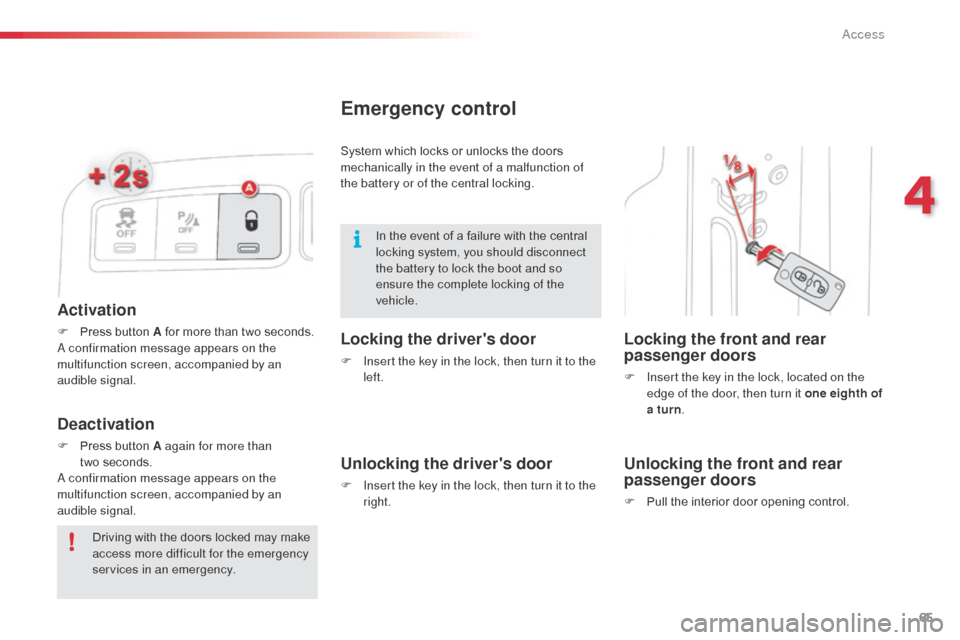
65
Activation
F Press button A for more than two seconds.
A confirmation message appears on the
multifunction screen, accompanied by an
audible signal.
Deactivation
F Press button A again for more than two seconds.
A confirmation message appears on the
multifunction screen, accompanied by an
audible signal.
Emergency control
Locking the front and rear
passenger doors
F Insert the key in the lock, located on the edge of the door, then turn it one eighth of
a turn .
Locking the driver's door
F Insert the key in the lock, then turn it to the
left.
Unlocking the driver's door
F Insert the key in the lock, then turn it to the right.
Unlocking the front and rear
passenger doors
F Pull the interior door opening control.
In the event of a failure with the central
locking system, you should disconnect
the battery to lock the boot and so
ensure the complete locking of the
vehicle.
System which locks or unlocks the doors
mechanically in the event of a malfunction of
the battery or of the central locking.
Driving with the doors locked may make
access more difficult for the emergency
services in an emergency.
4
Access
Page 70 of 296
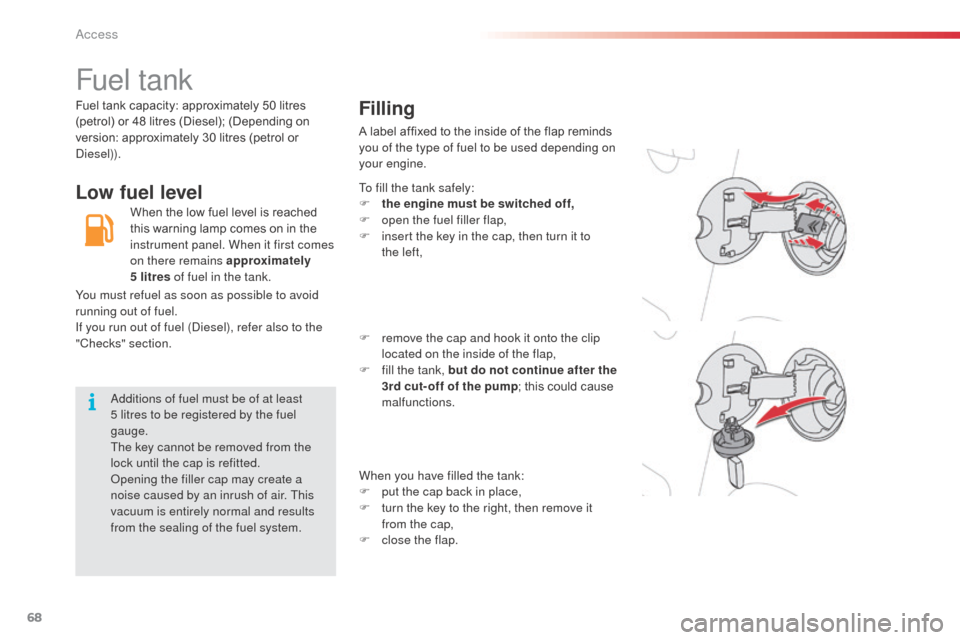
68
Fuel tank
Low fuel levelFilling
A label affixed to the inside of the flap reminds
you of the type of fuel to be used depending on
your engine.
When the low fuel level is reached
this warning lamp comes on in the
instrument panel. When it first comes
on there remains approximately
5
litres of fuel in the tank. To fill the tank safely:
F
t
he engine must be switched off,
F
o
pen the fuel filler flap,
F
i
nsert the key in the cap, then turn it to
the
left,
F
r
emove the cap and hook it onto the clip
located on the inside of the flap,
F
f
ill the tank, but do not continue after the
3rd cut- off of the pump ; this could cause
malfunctions.
When you have filled the tank:
F
p
ut the cap back in place,
F
t
urn the key to the right, then remove it
from the cap,
F
c
lose the flap.
Additions of fuel must be of at least
5
litres to be registered by the fuel
gauge.
The key cannot be removed from the
lock until the cap is refitted.
Opening the filler cap may create a
noise caused by an inrush of air. This
vacuum is entirely normal and results
from the sealing of the fuel system.
Fuel tank capacity: approximately 50 litres
(petrol) or 48 litres (Diesel); (Depending on
version: approximately 30 litres (petrol or
Diesel)).
You must refuel as soon as possible to avoid
running out of fuel.
If you run out of fuel (Diesel), refer also to the
"Checks" section.
Access
Page 83 of 296
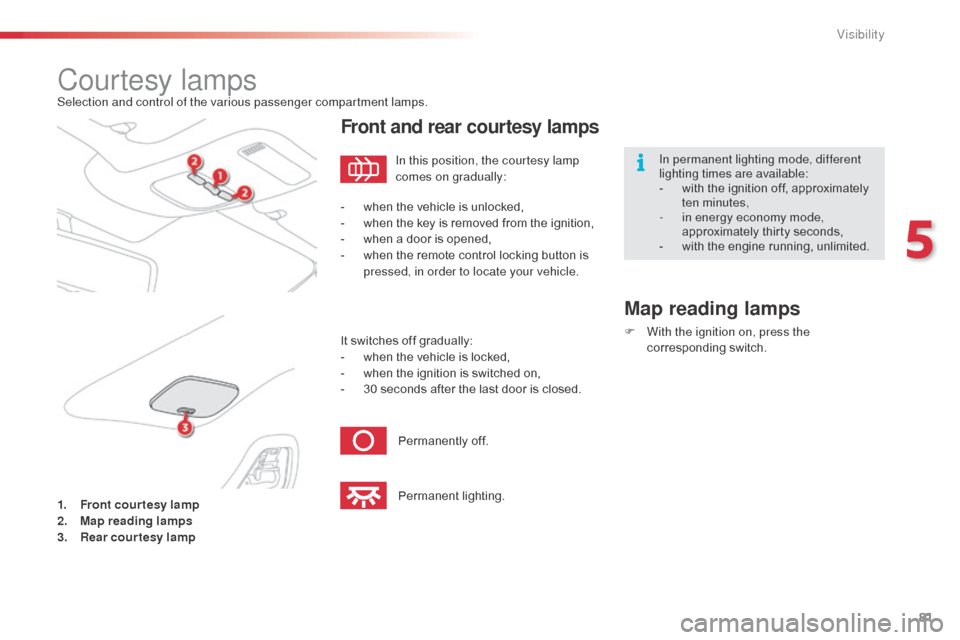
81
Courtesy lampsSelection and control of the various passenger compartment lamps.
1.
F
ront courtesy lamp
2.
M
ap reading lamps
3.
R
ear courtesy lamp
Front and rear courtesy lamps
Map reading lamps
F With the ignition on, press the corresponding switch.
In this position, the courtesy lamp
comes on gradually:
Permanently off.
Permanent lighting.
It switches off gradually:
-
w
hen the vehicle is locked,
-
w
hen the ignition is switched on,
-
3
0 seconds after the last door is closed.
-
w
hen the vehicle is unlocked,
-
w
hen the key is removed from the ignition,
-
w
hen a door is opened,
-
w
hen the remote control locking button is
pressed, in order to locate your vehicle. In permanent lighting mode, different
lighting times are available:
-
w
ith the ignition off, approximately
ten minutes,
-
i
n energy economy mode,
approximately thirty seconds,
-
w
ith the engine running, unlimited.
5
Visibility
Page 107 of 296
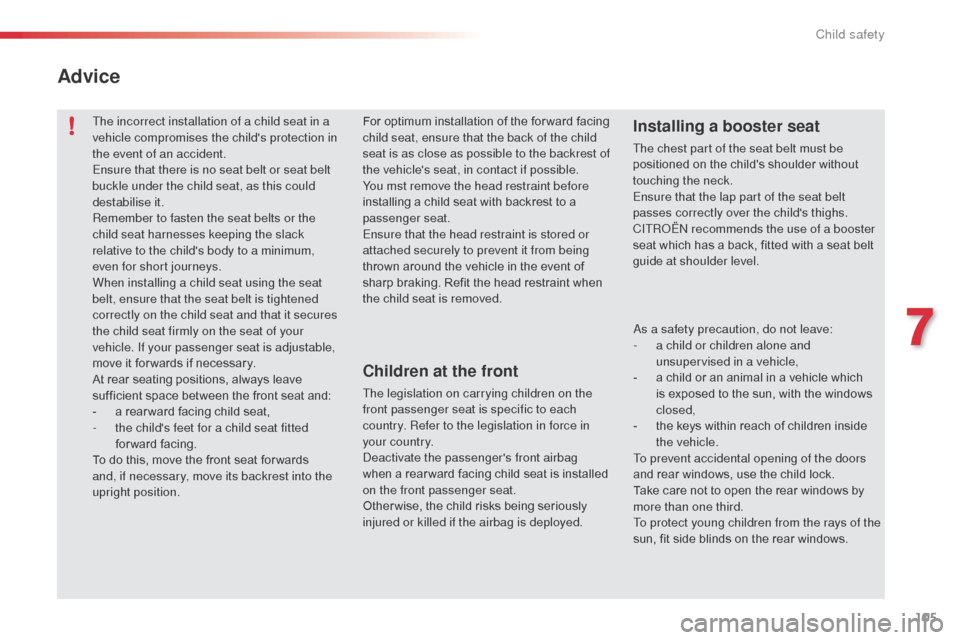
105
The incorrect installation of a child seat in a
vehicle compromises the child's protection in
the event of an accident.
Ensure that there is no seat belt or seat belt
buckle under the child seat, as this could
destabilise it.
Remember to fasten the seat belts or the
child seat harnesses keeping the slack
relative to the child's body to a minimum,
even for short journeys.
When installing a child seat using the seat
belt, ensure that the seat belt is tightened
correctly on the child seat and that it secures
the child seat firmly on the seat of your
vehicle. If your passenger seat is adjustable,
move it for wards if necessary.
At rear seating positions, always leave
sufficient space between the front seat and:
-
a r
ear ward facing child seat,
-
t
he child's feet for a child seat fitted
forward facing.
To do this, move the front seat for wards
and, if necessary, move its backrest into the
upright position. For optimum installation of the for ward facing
child seat, ensure that the back of the child
seat is as close as possible to the backrest of
the vehicle's seat, in contact if possible.
You mst remove the head restraint before
installing a child seat with backrest to a
passenger seat.
Ensure that the head restraint is stored or
attached securely to prevent it from being
thrown around the vehicle in the event of
sharp braking. Refit the head restraint when
the child seat is removed.
As a safety precaution, do not leave:
-
a c
hild or children alone and
unsupervised in a vehicle,
-
a c
hild or an animal in a vehicle which
is exposed to the sun, with the windows
closed,
-
t
he keys within reach of children inside
the vehicle.
To prevent accidental opening of the doors
and rear windows, use the child lock.
Take care not to open the rear windows by
more than one third.
To protect young children from the rays of the
sun, fit side blinds on the rear windows.Installing a booster seat
The chest part of the seat belt must be
positioned on the child's shoulder without
touching the neck.
Ensure that the lap part of the seat belt
passes correctly over the child's thighs.
CITROËN recommends the use of a booster
seat which has a back, fitted with a seat belt
guide at shoulder level.
Advice
Children at the front
The legislation on carrying children on the
front passenger seat is specific to each
country. Refer to the legislation in force in
your country.
Deactivate the passenger's front airbag
when a rear ward facing child seat is installed
on the front passenger seat.
Otherwise, the child risks being seriously
injured or killed if the airbag is deployed.
7
Child safety
Page 108 of 296
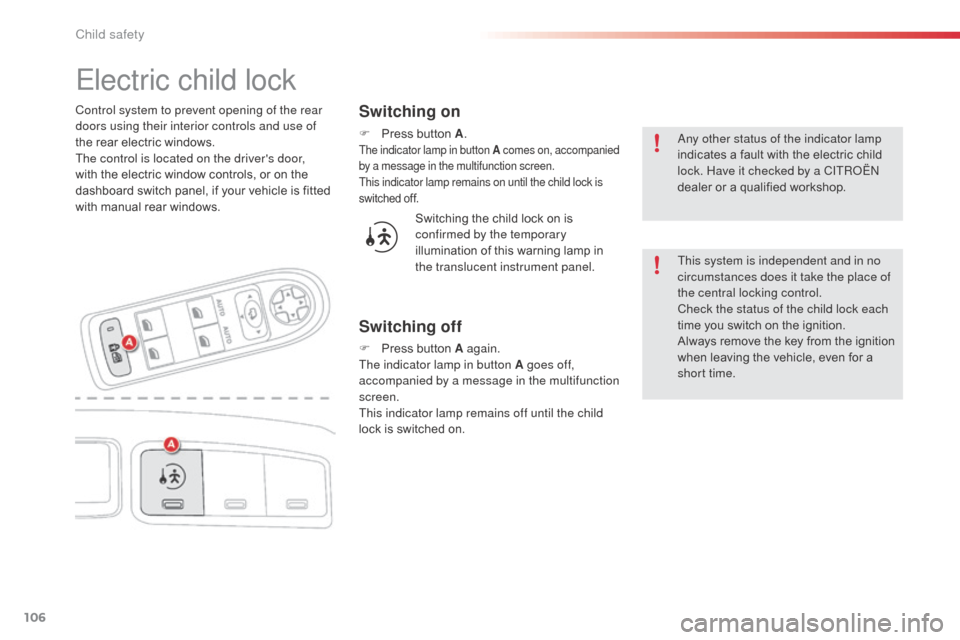
106
Electric child lock
Switching on
F Press button A.The indicator lamp in button A comes on, accompanied
by a message in the multifunction screen.
This indicator lamp remains on until the child lock is
switched off.
Switching off
F Press button A again.
The indicator lamp in button A goes off,
accompanied by a message in the multifunction
screen.
This indicator lamp remains off until the child
lock is switched on. Switching the child lock on is
confirmed by the temporary
illumination of this warning lamp in
the translucent instrument panel.
Any other status of the indicator lamp
indicates a fault with the electric child
lock. Have it checked by a CITROËN
dealer or a qualified workshop.
This system is independent and in no
circumstances does it take the place of
the central locking control.
Check the status of the child lock each
time you switch on the ignition.
Always remove the key from the ignition
when leaving the vehicle, even for a
short time.
Control system to prevent opening of the rear
doors using their interior controls and use of
the rear electric windows.
The control is located on the driver's door,
with the electric window controls, or on the
dashboard switch panel, if your vehicle is fitted
with manual rear windows.
Child safety
Page 121 of 296
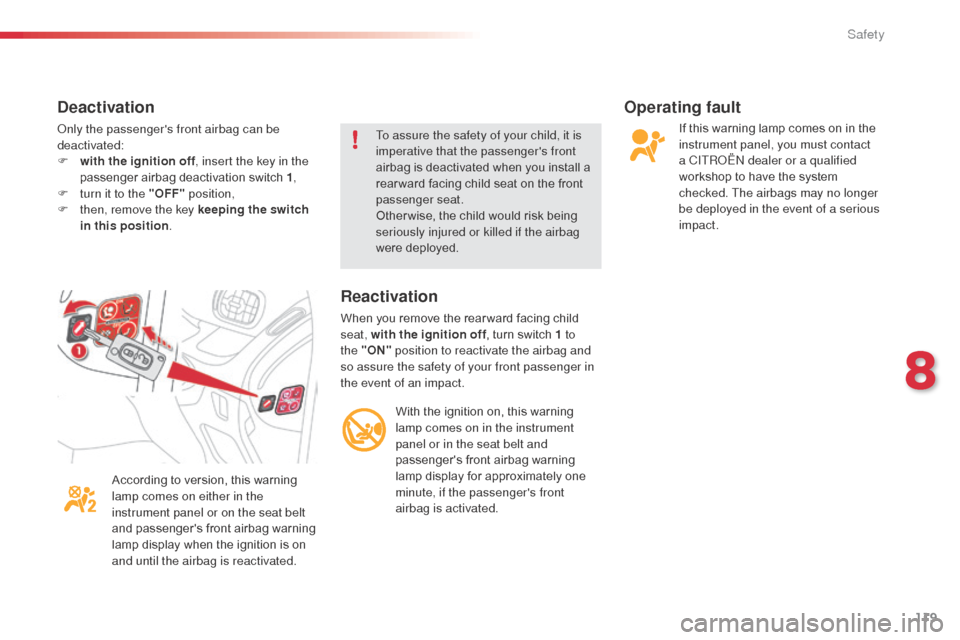
119
Operating fault
If this warning lamp comes on in the
instrument panel, you must contact
a CITROËN dealer or a qualified
workshop to have the system
checked. The airbags may no longer
be deployed in the event of a serious
impact.
Reactivation
When you remove the rear ward facing child
seat, with the ignition off, turn switch 1 to
the
"ON" position to reactivate the airbag and
so assure the safety of your front passenger in
the event of an impact.
With the ignition on, this warning
lamp comes on in the instrument
panel or in the seat belt and
passenger's front airbag warning
lamp display for approximately one
minute, if the passenger's front
airbag is activated.
According to version, this warning
lamp comes on either in the
instrument panel or on the seat belt
and passenger's front airbag warning
lamp display when the ignition is on
and until the airbag is reactivated.
Deactivation
Only the passenger's front airbag can be
deactivated:
F
w
ith the ignition off , insert the key in the
passenger airbag deactivation switch 1 ,
F
t
urn it to the "OFF" position,
F
t
hen, remove the key keeping the switch
in this position . To assure the safety of your child, it is
imperative that the passenger's front
airbag is deactivated when you install a
rear ward facing child seat on the front
passenger seat.
Other wise, the child would risk being
seriously injured or killed if the airbag
were deployed.
8
Safety
Page 125 of 296
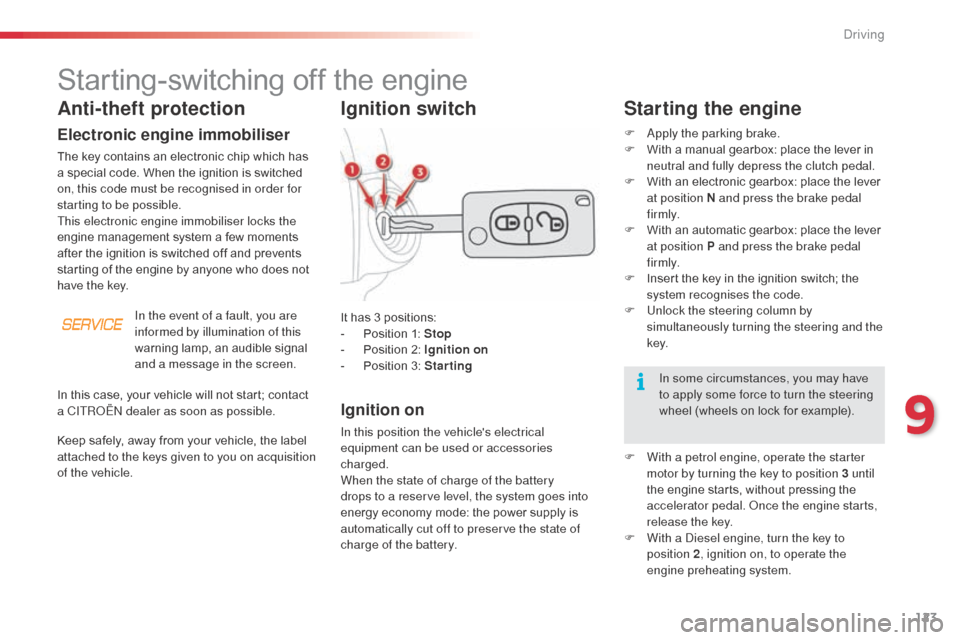
123
Electronic engine immobiliser
The key contains an electronic chip which has
a special code. When the ignition is switched
on, this code must be recognised in order for
starting to be possible.
This electronic engine immobiliser locks the
engine management system a few moments
after the ignition is switched off and prevents
starting of the engine by anyone who does not
have the key.
Anti-theft protection
In the event of a fault, you are
informed by illumination of this
warning lamp, an audible signal
and a message in the screen.
Ignition switch
It has 3 positions:
- P osition 1: Stop
-
P
osition 2: Ignition on
-
P
osition 3: Starting
Ignition on
In this position the vehicle's electrical
equipment can be used or accessories
charged.
When the state of charge of the battery
drops to a reserve level, the system goes into
energy economy mode: the power supply is
automatically cut off to preserve the state of
charge of the battery.
Keep safely, away from your vehicle, the label
attached to the keys given to you on acquisition
of the vehicle. In this case, your vehicle will not start; contact
a CITROËN dealer as soon as possible.
Starting-switching off the engine
Starting the engine
F Apply the parking brake.
F
W ith a manual gearbox: place the lever in
neutral and fully depress the clutch pedal.
F
W
ith an electronic gearbox: place the lever
at position N and press the brake pedal
f i r m l y.
F
W
ith an automatic gearbox: place the lever
at position P and press the brake pedal
f i r m l y.
F
I
nsert the key in the ignition switch; the
system recognises the code.
F
U
nlock the steering column by
simultaneously turning the steering and the
key.
F
W
ith a petrol engine, operate the starter
motor by turning the key to position 3 until
the engine starts, without pressing the
accelerator pedal. Once the engine starts,
release the key.
F
W
ith a Diesel engine, turn the key to
position 2 , ignition on, to operate the
engine preheating system. In some circumstances, you may have
to apply some force to turn the steering
wheel (wheels on lock for example).
9
Driving
Page 126 of 296
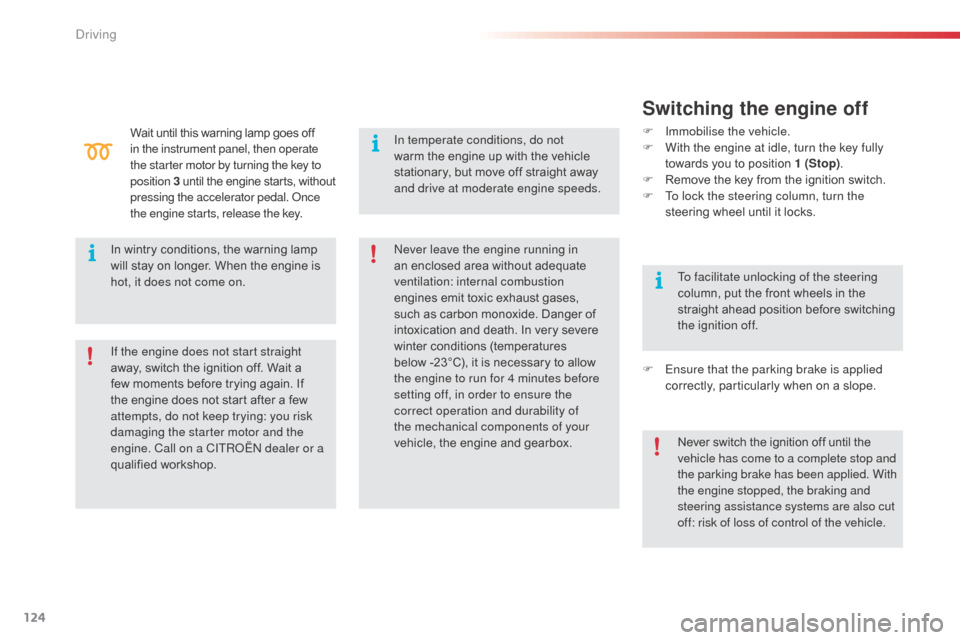
124
Never leave the engine running in
an enclosed area without adequate
ventilation: internal combustion
engines emit toxic exhaust gases,
such as carbon monoxide. Danger of
intoxication and death. In very severe
winter conditions (temperatures
below -23°C), it is necessary to allow
the engine to run for 4 minutes before
setting off, in order to ensure the
correct operation and durability of
the mechanical components of your
vehicle, the engine and gearbox.
If the engine does not start straight
away, switch the ignition off. Wait a
few moments before trying again. If
the engine does not start after a few
attempts, do not keep trying: you risk
damaging the starter motor and the
engine. Call on a CITROËN dealer or a
qualified workshop. In temperate conditions, do not
warm the engine up with the vehicle
stationary, but move off straight away
and drive at moderate engine speeds.
In wintry conditions, the warning lamp
will stay on longer. When the engine is
hot, it does not come on. Wait until this warning lamp goes off
in the instrument panel, then operate
the starter motor by turning the key to
position
3 until the engine starts, without
pressing the accelerator pedal. Once
the engine starts, release the key.
Switching the engine off
F Immobilise the vehicle.
F W ith the engine at idle, turn the key fully
towards you to position 1 (Stop) .
F
R
emove the key from the ignition switch.
F
T
o lock the steering column, turn the
steering wheel until it locks.
Never switch the ignition off until the
vehicle has come to a complete stop and
the parking brake has been applied. With
the engine stopped, the braking and
steering assistance systems are also cut
off: risk of loss of control of the vehicle. To facilitate unlocking of the steering
column, put the front wheels in the
straight ahead position before switching
the ignition off.
F
E
nsure that the parking brake is applied
correctly, particularly when on a slope.
Driving
Page 127 of 296
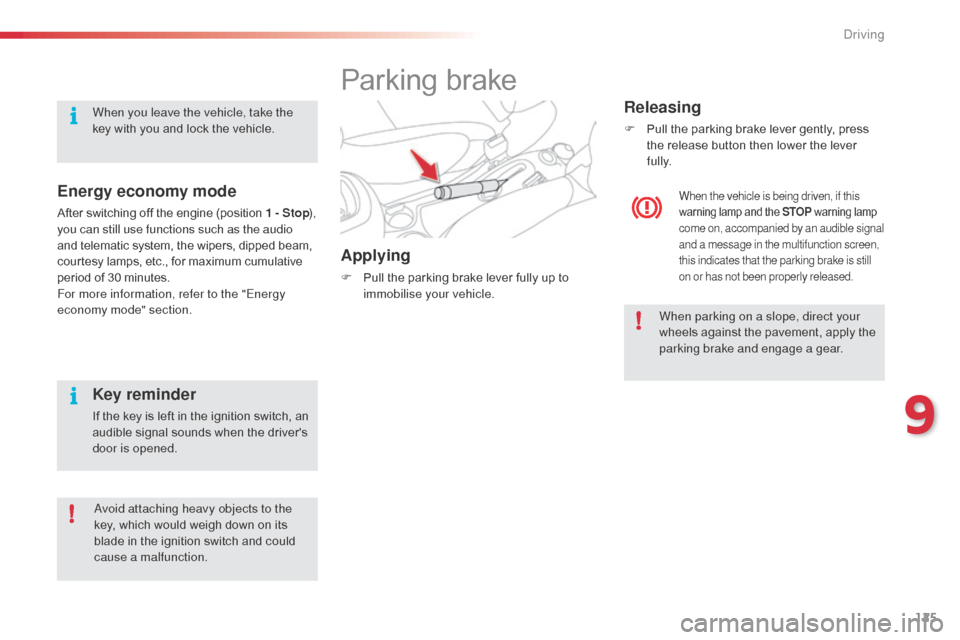
125
Parking brake
Applying
F Pull the parking brake lever fully up to immobilise your vehicle.
When the vehicle is being driven, if this
warning lamp and the STOP warning lamp
come on, accompanied by an audible signal
and a message in the multifunction screen,
this indicates that the parking brake is still
on or has not been properly released.
Releasing
F Pull the parking brake lever gently, press the release button then lower the lever
fully.
When parking on a slope, direct your
wheels against the pavement, apply the
parking brake and engage a gear.
When you leave the vehicle, take the
key with you and lock the vehicle.
Energy economy mode
After switching off the engine (position 1 - Stop
),
you can still use functions such as the audio
and telematic system, the wipers, dipped beam,
courtesy lamps, etc., for maximum cumulative
period of 30 minutes.
For more information, refer to the "Energy
economy mode" section.
Key reminder
If the key is left in the ignition switch, an
audible signal sounds when the driver's
door is opened.
Avoid attaching heavy objects to the
key, which would weigh down on its
blade in the ignition switch and could
cause a malfunction.
9
Driving
Page 169 of 296
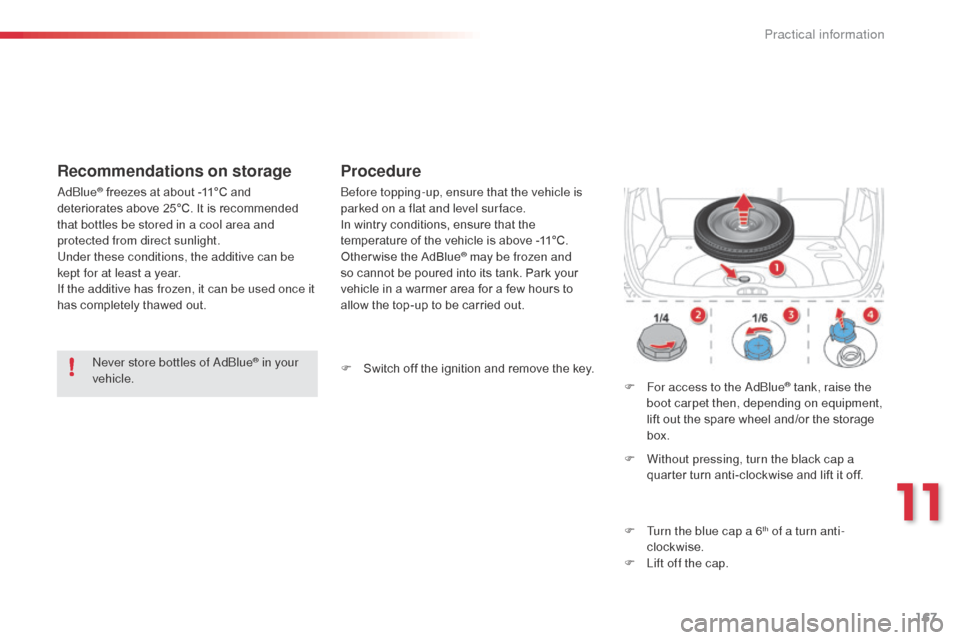
167
Never store bottles of AdBlue® in your
vehicle.
AdBlue
® freezes at about -11°C and
deteriorates above 25°C. It is recommended
that bottles be stored in a cool area and
protected from direct sunlight.
Under these conditions, the additive can be
kept for at least a year.
If the additive has frozen, it can be used once it
has completely thawed out.
Recommendations on storage
Before topping-up, ensure that the vehicle is
parked on a flat and level sur face.
In wintry conditions, ensure that the
temperature of the vehicle is above -11°C.
Otherwise the AdBlue
® may be frozen and
so cannot be poured into its tank. Park your
vehicle in a warmer area for a few hours to
allow the top-up to be carried out.
Procedure
F For access to the AdBlue® tank, raise the
boot carpet then, depending on equipment,
lift out the spare wheel and/or the storage
box.
F
W
ithout pressing, turn the black cap a
quarter turn anti-clockwise and lift it off.
F
T
urn the blue cap a 6
th of a turn anti-
clockwise.
F
L
ift off the cap.
F
S
witch off the ignition and remove the key.
11
Practical information